You found our list of top improv books.
Improv books are guides that teach readers how to act off-script in improvisational scenes. These guides cover topics such as overcoming self-consciousness and a fear of failure, actively listening and paying attention to body language, and embracing curiosity. While actors tend to read these books most, you can also read these books in the workplace to improve employee’s reaction and problem solving skills and boost team building efforts.
These guides can help to improve team cooperation in the workplace and make large group improv games and Zoom improv activities more successful. These books are similar to books on innovation and books on creativity.
This article includes:
- improv books for beginners
- books of improv games
- business improv books
- books on improv for work
Here we go!
List of improv books
Here is a list of books on improv for work to improve teamwork, communication, and decision-making skills.
1. Getting to “Yes And”: The Art of Business Improv by Bob Kulhan and Chuck Crisafulli
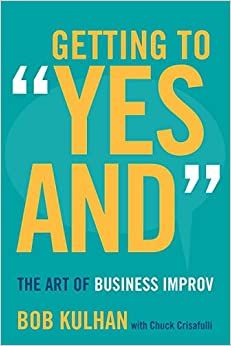
Getting to “Yes And” is one of the best business improv books. The book demonstrates how to apply the principles of improv to professional interactions. The authors explain that the same mindsets and behaviors that make improv scenes entertaining can also help improve teamwork, decision making and problem solving, brainstorming, and conflict resolution. The chapters highlight the improvisational concepts that have the most practical uses in the business world, such as being open-minded to opportunity and maintaining steady energy. Getting to “Yes And” teaches professionals how to adapt to change and react to the unexpected without getting flustered.
Notable Quote: “Improvisation thrives at the pivotal intersection where planning and strategy meet execution.”
Read Getting to “Yes And”.
2. Yes, And: How Improvisation Reverses “No, but” Thinking and Improves Creativity and Collaboration – Lessons from the Second City by Kelly Leonard and Tom Yorton
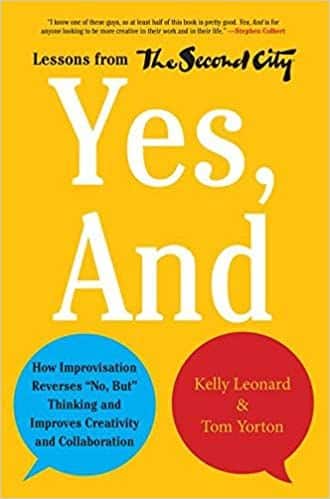
Yes, And is written by leaders of The Second City, which is one of the top improv groups in the world. The authors apply the fundamentals of improv to industry and show how strengthening improvisational abilities can boost work performance. The pages use the practice of acting off-script to give advice on team development, change management, and innovation. Yes, And shows readers how to keep an open mind and a positive attitude, listen and read body language, develop a rapport and effectively collaborate, and be unafraid to experiment.
Notable Quote: “Too often we are told that failure is not an option. But the opposite is true. It’s vital to give failure a role in your process. The biggest threat to creativity is fear, especially the fear of failure. By deflating the negative power of failure, you erode fear and allow creativity to flourish.”
Read Yes, And.
3. The Art of Making Sh!t Up: Using the Principles of Improv to Become an Unstoppable Powerhouse by Norm Laviolette
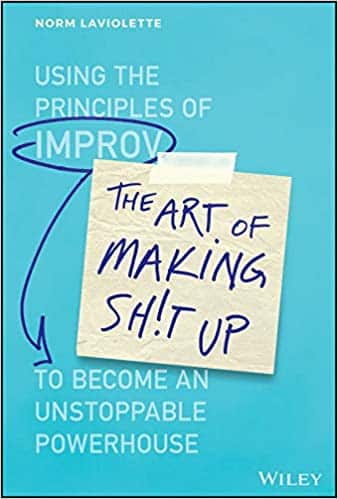
The Art of Making Sh!t Up shows how to leverage improv skills to boost presentation capabilities and overall work performance. Norm Laviolette describes how to apply improv techniques to the workplace and shows how the practice can make workers more inclusive, productive, and enthusiastic. The book explains how to face self-doubt and embrace instincts, bounce back from failure, build a tolerance towards the uncomfortable, and build off of teammates’ ideas. The Art of Making Sh!t Up empowers readers to overcome imposter syndrome, embrace uncertainty, and enjoy the experience of spontaneous creation.
Notable Quote: “Originality and innovation blossoms from deep in the recesses of the mind, not because some people have the magical creative gene, but because they have overcome the fear of judgment of others and themselves.”
Read The Art of Making Sh!t Up.
4. Truth in Comedy: The Manual for Improvisation by Charna Halpern, Del Close, and Kim Howard Johnson
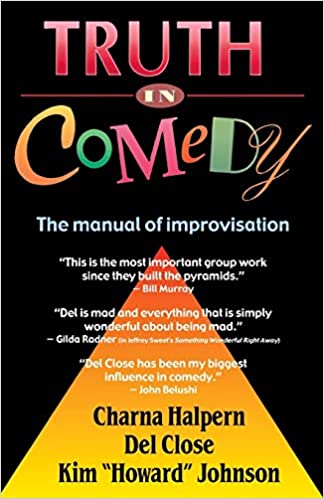
Truth in Comedy is one of the most-often-recommended improv books for beginners. The book analyzes the basic elements of improv scenes and provides guiding principles for performing on the fly. The authors put a heavy emphasis on storytelling and group work, two concepts that translate into the working world. Chapters also cover similar relevant work topics such as agreement, trust, and environmental awareness. The pages contain several exercises that help participants develop the skills and instincts necessary to create in the moment and react without hesitation.
Notable Quote: “Honesty, discovery, observation, and reaction is better than contrived invention.”
Read Truth in Comedy.
5. How to be the Greatest Improviser on Earth by Will Hines
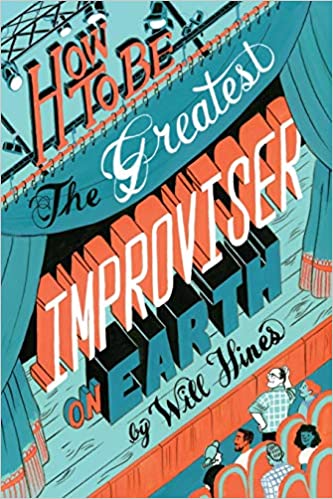
How to be the Greatest Improviser on Earth is a handbook for performing improv. Will Hines is a member and teacher of the Upright Citizens Brigade Theatre, and draws on decades of experience to offer advice on navigating scenes. Though the focus of the book is on performing comedy, there are nuggets of wisdom that translate into the working world as well, such as remaining present, being flexible and adaptable, understanding the driving forces of conflict, and acting with boldness and confidence. This guide emphasizes authenticity and shows how to leverage natural talents and instincts to connect more naturally and resonate with your audience.
Notable Quote: “The hard truth is often simply: learn to act like a normal person.”
Read How to be the Greatest Improviser on Earth.
6. The Improv Handbook: The Ultimate Guide to Improvising in Comedy, Theatre, and Beyond by Tom Salinsky and Deborah Frances-White
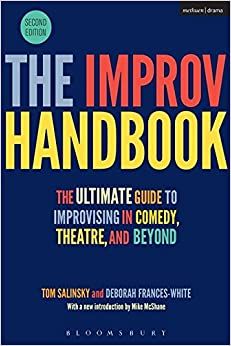
The Improv Handbook is one of the top improv books for beginners. This book acts as a comprehensive guide to the world of improv and covers a variety of topics ranging from the basics of scene work, to performing in public, to marketing improv instructional skills and translating the art to the corporate world. The final section of the book consists of a series of interviews with renowned improvisers who offer up advice for refining the craft. The Improv Handbook gives tips on working together, surrendering control and trusting teammates, and creating a larger narrative bit by bit.
Notable Quote: “Improvisation has a tremendous power to liberate, inspire, and enthuse.”
Read The Improv Handbook.
7. Group Improvisation: The Manual of Ensemble Improv Games by Peter Gwinn and Charna Halpern
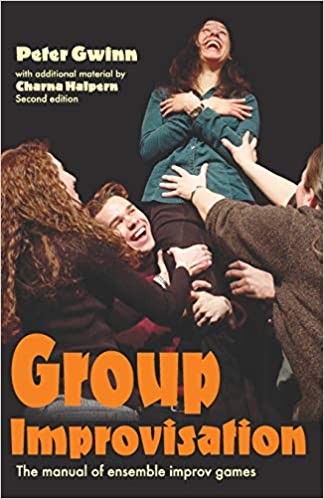
Group Improvisation is one of the best books of improv games for work. The book has hundreds of improv exercises meant to be done in teams. The games are grouped by intention, and sections dedicated to results such as bonding, focus, creativity, and energy. The ultimate goal of these activities is to help group members grow to know and trust each other, and to create stronger team dynamics. These aims are especially relevant to the workplace, and can serve as the inspiration to do improv with teams. Group Improvisation is an invaluable tool for leaders looking to guide teams through improv activities.
Notable Quote: “The Group Mind is the Holy Grail of improvisation. It is the magic part of improvisation. It is the moment on-stage suddenly know what one another will do before they do it.”
Read Group Improvisation.
8. Improv Wisdom: Don’t Prepare, Just Show Up by Patricia Ryan Madson
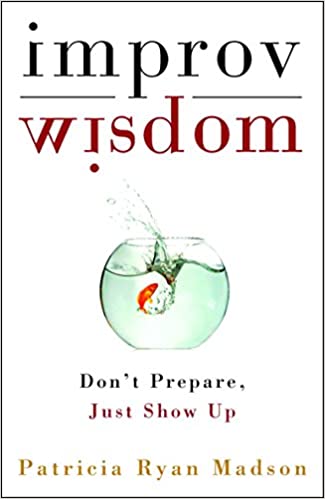
Improv Wisdom is a collection of practical life advice inspired by improv. Patricia Ryan highlights thirteen key takeaways from the art, such as start anywhere, pay attention, and take care of each other. Each chapter explores the guiding concept in depth, and shares motivational mantras to give readers the courage to explore impulses and take risks. The book challenges the conventional wisdom of planning and preparing every detail and shows how some of the greatest growth comes from taking action despite uncertainty. In the working world professionals rarely have perfect conditions or complete information, and responding in real time is a valuable skill. Improv Wisdom shows the mental and emotional perk to practicing improvisation and outlines the ways readers can benefit from being more spontaneous.
Notable Quote: “Trust your imagination. There is always something in the box.”
Read Improv Wisdom.
9. Improvise: Scene from the Inside Out by Mick Napier
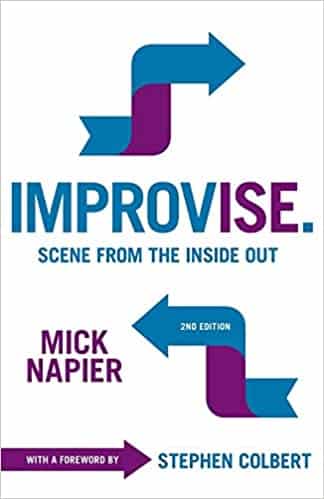
Improvise: Scene from the Inside Out challenges the traditional rules of improv. Mick Napier argues that the golden rules of improv often lead to actors overthinking and can make a scene boring. This guide shows that magic happens when actors have an understanding of when and how to break the rules, which is a concept that also applies to the workplace. The book examines how to diagnose and resolve common problems in scenes, guide the story, develop a rapport with a partner, and use context effectively. Improvise: Scene from the Inside Out gives readers a set of flexible guidelines and critical thinking abilities rather than hard and fast rules, and is one of the best examples of how to put theories of improv into practice.
Notable Quote: “If improvisers aren’t truly playing then they are “thinking about.” If fear has them thinking in this way at the beginning of the scene, they are sure to discover that their scene is boring from the audience’s perspective. The consequence of that realization is more fear and confusion.”
Read Improvise.
10. Impro: Improvisation and the Theatre by Keith Johnstone
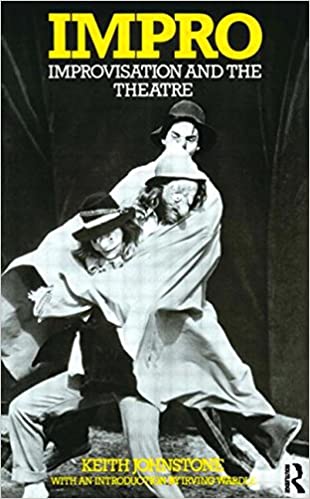
No list of improv books would be complete without Impro. This work is often considered to be one of the definitive guides to the art of improv. The book consists of four main sections– status, spontaneity, narrative skills, and mask & trance. The tone is at times scholarly and the prose can be dense. However the text contains many insightful reflections on the nature of creativity and the importance of spontaneity as well as advice on how to persuade and captivate audiences. Though aimed at the theatre world, this book has value to the work world as well, particularly in disciplines such as sales, marketing, and advertising. In fact, Daniel Pink makes reference to this guide in his book To Sell is Human, and many of Keith Johnstone’s words of wisdom can also double as tactics to find career success. Impro gives psychological and behavioral context to the world of improv and shows readers how to develop and deepen the discipline as well as how to apply these principles to other areas of life.
Notable Quote: “There are people who prefer to say ‘yes’ and there are people who prefer to say ‘no’. Those who say ‘yes’ are rewarded by the adventures they have. Those who say ‘no’ are rewarded by the safety they attain.”
Read Impro: Improvisation and the Theatre.
Final thoughts
Books on improv are not just for actors. Within the pages of these guides lie countless lessons for the business world, human relationships, and life in general. These books teach readers how to observe and stay alert, use nonverbal communication, overcome a fear of making mistakes or looking foolish, and respond instantaneously. These guides show that genius does not have to be the result of careful planning and gradual execution, and can also be a product of experimentation and spontaneous creation. The books give readers the tools and skills necessary to react in the moment, communicate more effectively, support and rely on collaborators, and make creativity look effortless.
Next, check out this improv prompt generator and this list of community building activities.
We also have a list of communication books, list of problem solving books, and a list of books on decision making.
